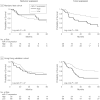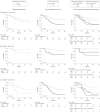MicroRNA expression profiles associated with prognosis and therapeutic outcome in colon adenocarcinoma
- PMID: 18230780
- PMCID: PMC2614237
- DOI: 10.1001/jama.299.4.425
MicroRNA expression profiles associated with prognosis and therapeutic outcome in colon adenocarcinoma
Abstract
Context: MicroRNAs have potential as diagnostic biomarkers and therapeutic targets in cancer. No study has evaluated the association between microRNA expression patterns and colon cancer prognosis or therapeutic outcome.
Objective: To identify microRNA expression patterns associated with colon adenocarcinomas, prognosis, or therapeutic outcome.
Design, setting, and patients: MicroRNA microarray expression profiling of tumors and paired nontumorous tissues was performed on a US test cohort of 84 patients with incident colon adenocarcinoma, recruited between 1993 and 2002. We evaluated associations with tumor status, TNM staging, survival prognosis, and response to adjuvant chemotherapy. Associations were validated in a second, independent Chinese cohort of 113 patients recruited between 1991 and 2000, using quantitative reverse transcription polymerase chain reaction assays. The final date of follow-up was December 31, 2005, for the Maryland cohort and August 16, 2004, for the Hong Kong cohort.
Main outcome measures: MicroRNAs that were differentially expressed in tumors and microRNA expression patterns associated with survival using cancer-specific death as the end point. RESULTS Thirty-seven microRNAs were differentially expressed in tumors from the test cohort. Selected for validation were miR-20a, miR-21, miR-106a, miR-181b, and miR-203, and all 5 were enriched in tumors from the validation cohort (P < .001). Higher miR-21 expression was present in adenomas (P = .006) and in tumors with more advanced TNM staging (P < .001). In situ hybridization demonstrated miR-21 to be expressed at high levels in colonic carcinoma cells. The 5-year cancer-specific survival rate was 57.5% for the Maryland cohort and was 49.5% for the Hong Kong cohort. High miR-21 expression was associated with poor survival in both the training (hazard ratio, 2.5; 95% confidence interval, 1.2-5.2) and validation cohorts (hazard ratio, 2.4; 95% confidence interval, 1.4-3.9), independent of clinical covariates, including TNM staging, and was associated with a poor therapeutic outcome.
Conclusions: Expression patterns of microRNAs are systematically altered in colon adenocarcinomas. High miR-21 expression is associated with poor survival and poor therapeutic outcome.
Figures




Comment in
-
MicroRNA expression in colon adenocarcinoma.JAMA. 2008 Jun 11;299(22):2628; author reply 2628-9. doi: 10.1001/jama.299.22.2628-a. JAMA. 2008. PMID: 18544721 No abstract available.
References
-
- Aaltonen LA, Hamilton SR. Pathology and Genetics of Tumours of the Digestive System. International Agency for Research on Cancer Press; Lyon, France: 2000. World Health Organization Classification of Tumors.
-
- Jemal A, Siegel R, Ward E, Murray T, Xu J, Thun MJ. Cancer statistics, 2007. CA Cancer J Clin. 2007;57(1):43–66. - PubMed
-
- Goldman E, Fisher JL. Discrepancies in cancer mortality estimates. Arch Med Res. 2006;37(4):548–551. - PubMed
-
- Rodriguez-Bigas MA, Hoff P, Crane CH. Carcinoma of the colon and rectum. In: Kufe DW, Bast RC, Hait WN, et al., editors. Holland-Frei Cancer Medicine 7. 7th ed BC Decker Inc; Hamilton, Ontario: 2006. pp. 1369–1391.
-
- Calin GA, Croce CM. MicroRNA signatures in human cancers. Nat Rev Cancer. 2006;6(11):857–866. - PubMed
Publication types
MeSH terms
Substances
Grants and funding
LinkOut - more resources
Full Text Sources
Other Literature Sources
Molecular Biology Databases

